
 Whether you’re influenced by “fear tactics” or not, the cold statistics about table saw injuries are frightening: there’s a table saw accident in the United States every nine minutes, and by the end of each day, 10 more table saw users are suffering from amputation injuries. Look at both of your hands for a moment: if you can count 10 functioning fingers and you use a table saw, consider yourself lucky. I do.
Whether you’re influenced by “fear tactics” or not, the cold statistics about table saw injuries are frightening: there’s a table saw accident in the United States every nine minutes, and by the end of each day, 10 more table saw users are suffering from amputation injuries. Look at both of your hands for a moment: if you can count 10 functioning fingers and you use a table saw, consider yourself lucky. I do.
Over the past decade, few will argue that any other table saw manufacturer has done more to improve table saw safety than SawStop. The company’s blade brake technology, which senses contact with skin and stops the blade within five milliseconds, has saved many woodworkers and other saw users from devastating hand injuries. And Matt Howard, SawStop’s vice president of marketing, knows the truth of it by the continuous testimonial feedback he receives.
“Every week I open another email from a saw user who lost fingers to table saws. They talk about the impact on their lives and their business. They send horrifying pictures. And most of all, they talk about regret. Every single time we ship a saw, that’s at least one operator who won’t have to live with that regret for the rest of their lives. That’s one more person who may send me a photo of the scratch on their finger and how SawStop saved their hand.”
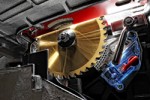 This month, SawStop is celebrating a decade milestone and the happy benefits of preventing accidents: the company now has shipped its 50,000th table saw since it began producing them in 2004. Most of these saws are located in the United States, with Canadian users coming in a close second. According to SawStop, it now is the “number one” cabinet saw in North America. Its flesh-sensing table saws are also available in Australia, China, Taiwan, South Korea and Japan.
This month, SawStop is celebrating a decade milestone and the happy benefits of preventing accidents: the company now has shipped its 50,000th table saw since it began producing them in 2004. Most of these saws are located in the United States, with Canadian users coming in a close second. According to SawStop, it now is the “number one” cabinet saw in North America. Its flesh-sensing table saws are also available in Australia, China, Taiwan, South Korea and Japan.
Howard says that no single SawStop model outranks the others in popularity: the company’s two versions of cabinet saws and a contractor’s saw are closely matched in terms of demand. They’re also evenly distributed among a wide cross-section of users, which include professional woodworkers, hobbyists, industrial applications and education environments. But, while the company is pleased with the broad appeal, Howard is most gratified by how many full-time woodworkers choose SawStop over other brands. “We are now the reference saw in cabinet shops. That means seasoned pros are seeing the SawStop value and recommending it to their friends,” he says.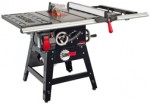
If you aren’t aware, the Tualatin, Oregon-based SawStop boasts that it is “100 percent U.S. owned, operated and engineered.” However, manufacturing takes place in Taiwan (where most consumer-grade table saws are made these days, regardless of brand), but Howard assures that the company maintains extremely rigorous manufacturing tolerances and tough inspections. “Our quality reputation is proof that these processes work.”
 Aside from stringent manufacturing standards, SawStop also prides itself on its singular focus and in-house know-how. “All we do is table saws,” Howard says, “and we’ve taken all our time to meticulously engineer every tiny part of each saw. We avoid off-the-shelf engineering, because experience has taught us that with some effort we can do it better ourselves.” Customer service also is a priority: calls receive a technical expert on the other end of the line, not an automated reply.
Aside from stringent manufacturing standards, SawStop also prides itself on its singular focus and in-house know-how. “All we do is table saws,” Howard says, “and we’ve taken all our time to meticulously engineer every tiny part of each saw. We avoid off-the-shelf engineering, because experience has taught us that with some effort we can do it better ourselves.” Customer service also is a priority: calls receive a technical expert on the other end of the line, not an automated reply.
Table saws continue to be a broad market shared by many companies, but SawStop is the only brand with blade brake technology. Not surprisingly, even a technologically safer saw will have its critics — both within the saw industry and from some saw users, too. Howard says he often hears four main criticisms about SawStop products. Here’s how he responds to them: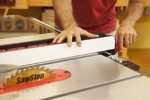
1. SawStop saws are more expensive. “Sometimes we’re higher, but I guarantee our quality and safety is worth it. Other times we’re less expensive. For instance, compare a 3hp SawStop Professional Cabinet Saw to a similarly equipped Powermatic PM2000 or Delta Unisaw.”
2. SawStop saws are expensive to reset once the blade brake has been activated.Instead of costing hundreds of dollars, as some believe, Howard says the cost of resetting the saw is and always has been $69 for a new blade brake cartridge plus the cost of whatever blade the end user wishes to use. “You can do the reset yourself in five minutes. No technicians required.”
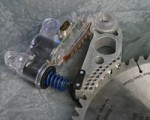 3. Once the cartridge activates, a saw is effectively “broken” thereafter. Howard assures that SawStop saws continue to be “quite intact and in good order” after a skin-sensing incident. In fact, at every biannual International Woodworking Fair (IWF) trade show in Atlanta, the company activates the same saw once an hour for five days in its booth presentations. At the end of the show, “that saw cuts just as true as before the show started.”
3. Once the cartridge activates, a saw is effectively “broken” thereafter. Howard assures that SawStop saws continue to be “quite intact and in good order” after a skin-sensing incident. In fact, at every biannual International Woodworking Fair (IWF) trade show in Atlanta, the company activates the same saw once an hour for five days in its booth presentations. At the end of the show, “that saw cuts just as true as before the show started.”
4. SawStop once made a retrofit kit for other table saws. This claim, Howard says, has always been untrue. “The system must be designed to stop in less than 5 milliseconds, and to stop every time. The only way that can be accomplished is by way of a fully integrated, ground-up design.”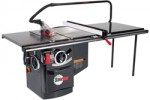
Despite having now reached the 50,000-saw-shipped milestone, Howard won’t venture a guess as to when the day will come that SawStop’s blade brake technology will actually shift the needle measurably on table saw accident statistics. Even with steady growth over the coming years, he’s certain that SawStop will still make “just a small dent” in the number of accidents that occur with conventional table saws every day.
Still, the company will continue to innovate new products to help more woodworkers stay productive and out of emergency rooms. For instance, SawStop currently is working on a jobsite table saw that will weigh under 100 lbs., be portable and complete with flesh detection. Its release date has not been determined yet. However, Howard says this fall, SawStop will unveil a high quality crosscut sliding table attachment for its saws, in response to customer requests. “I’m thrilled with what we’ve come up with here,” he teases.
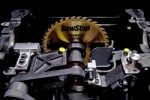 While SawStop never actually set a 10-year shipment goal, Howard says, reaching this year’s milestone warrants celebration. It shows that woodworkers really do care about safety and believe that SawStop — a relative newcomer to the table saw market — can help them achieve it.
While SawStop never actually set a 10-year shipment goal, Howard says, reaching this year’s milestone warrants celebration. It shows that woodworkers really do care about safety and believe that SawStop — a relative newcomer to the table saw market — can help them achieve it.
“The popularity of our saws has been the best validation. Not just our products themselves, but also saw users’ thirst for safer woodworking … that’s a huge win, and each win is reason enough for all of us at SawStop to love coming to work each day.”






